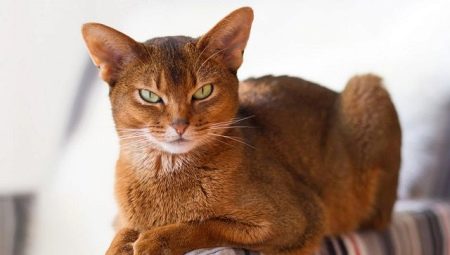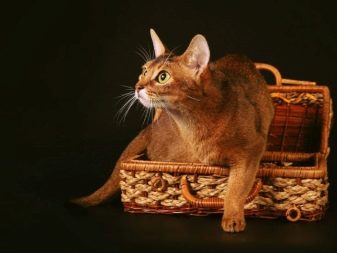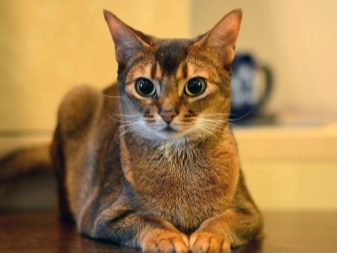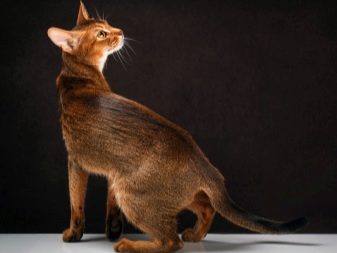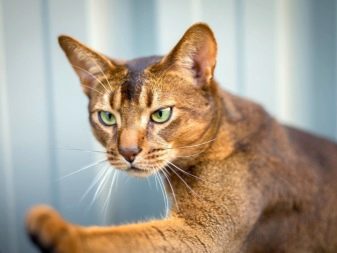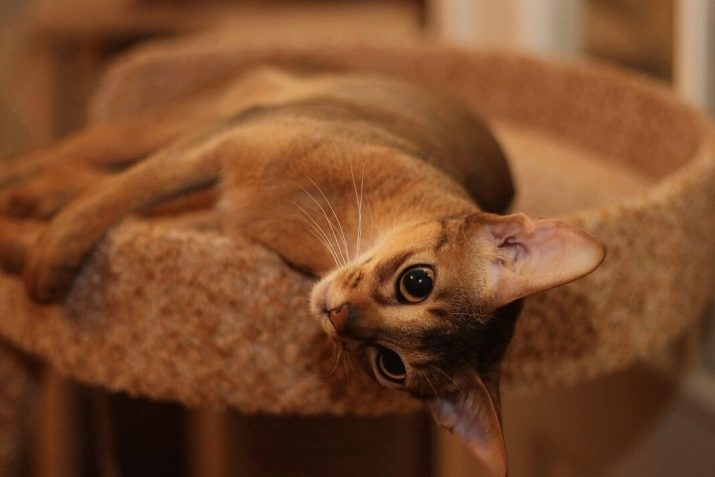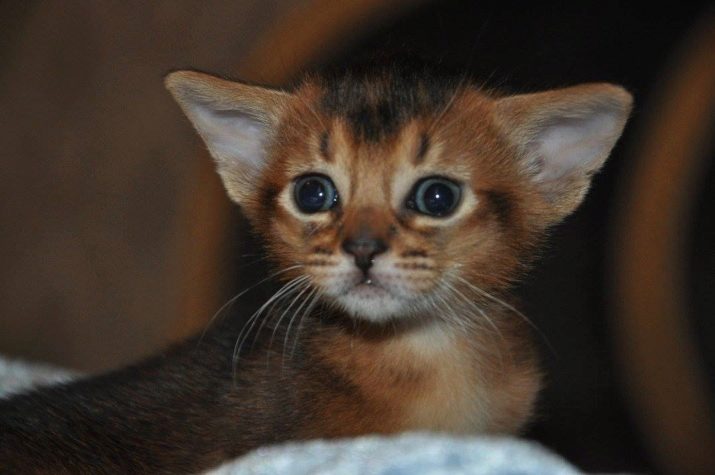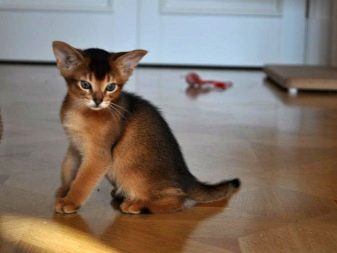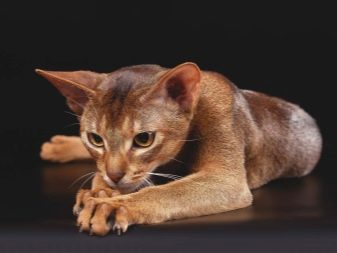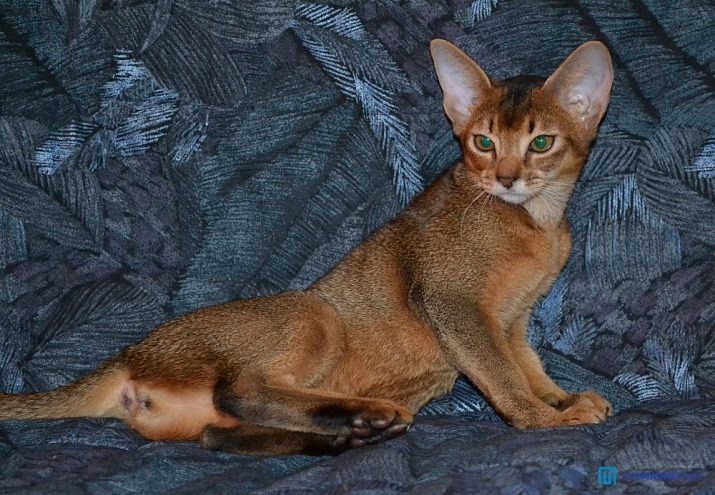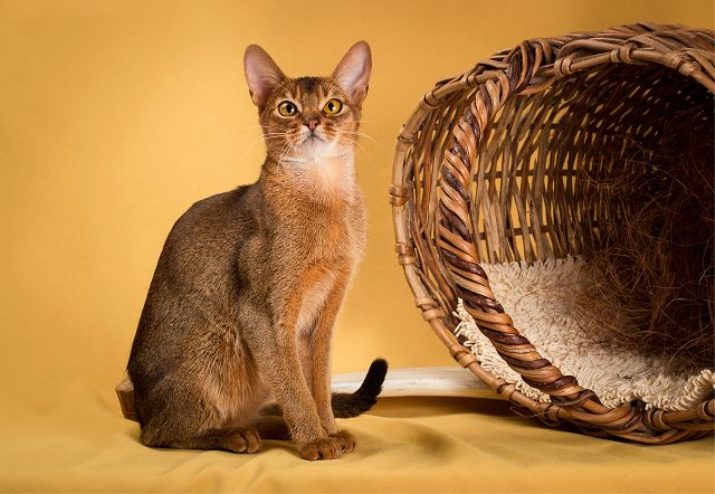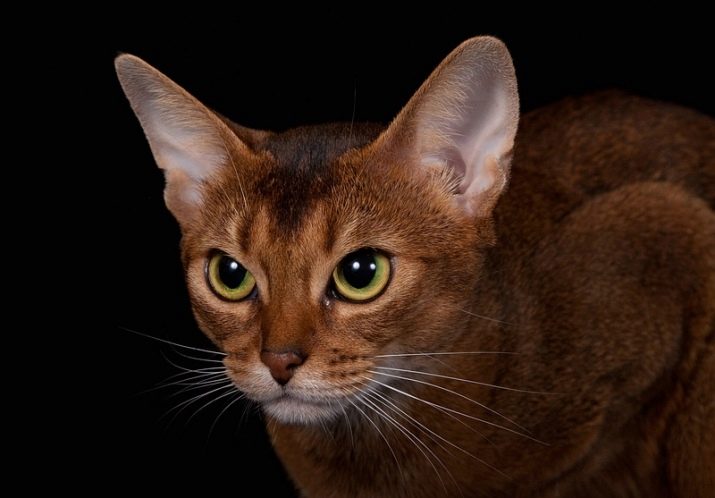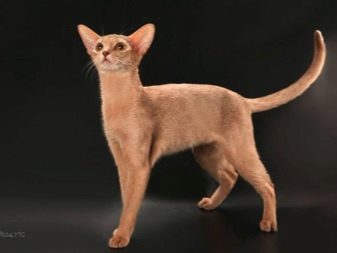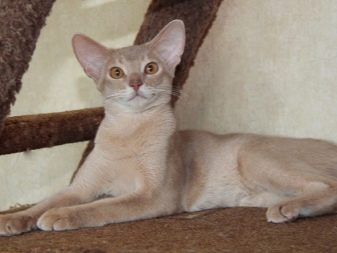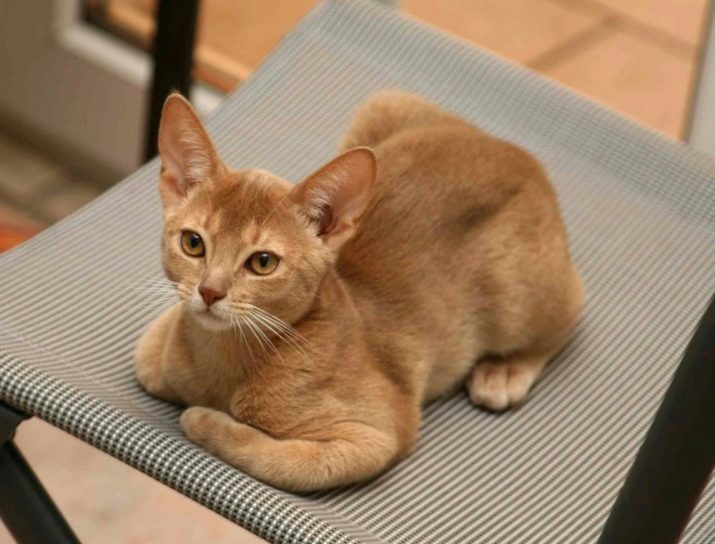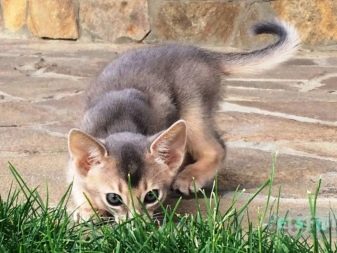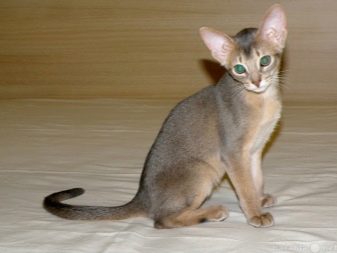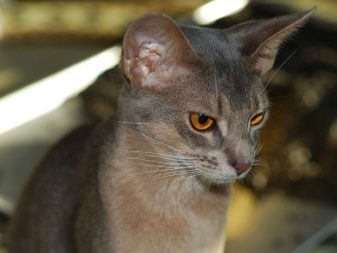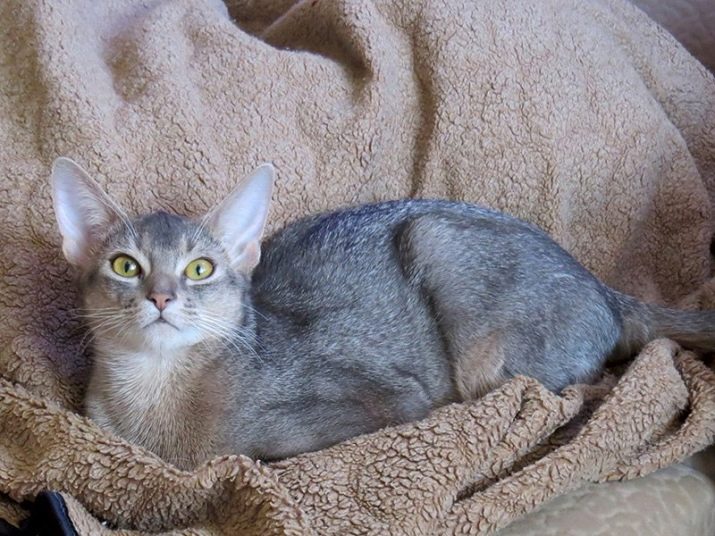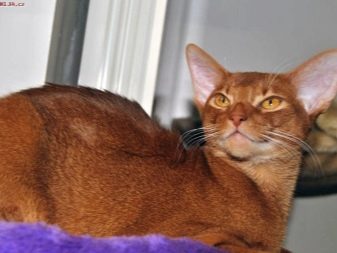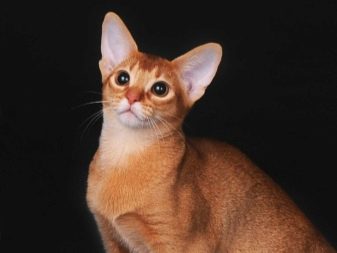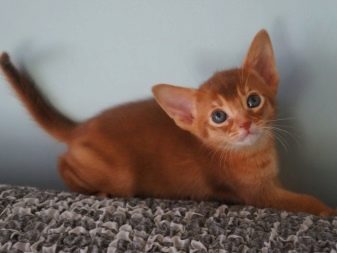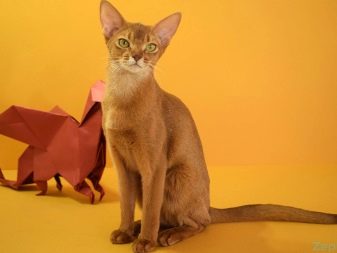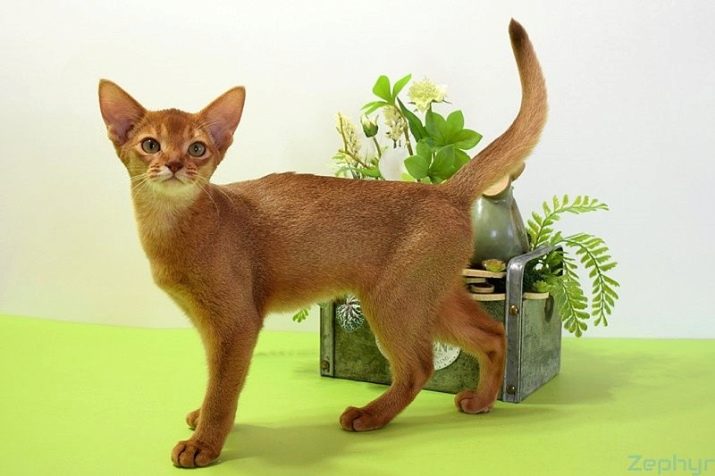Abyssinian - one of the oldest cat breeds. She was brought to England from Ethiopia in the XIX century, and in 1900, American breeders brought it to the United States. The ancestors of these royal animals lived in ancient Egypt, where they were revered as the earthly incarnation of the goddess Bastet. Pharaohs and grandees decorated their tombs with graceful Abyssinian images. The cult of the goddess Bastet fell into decay many centuries ago, however, the Abyssinian cat does not lose popularity in our days.
Breeders and ordinary cat lovers choose this breed for its amazing color, playful and sociable character.
Color overview
The Abyssinian cat has a graceful appearance: a slim, moderately muscular body, large almond-shaped eyes, large pointed ears, as well as an elegant long neck. But one of its main differences and advantages is the color. Each hair of her coat is painted simultaneously in several colors - this color is called ticking or zonal. On each villus there are at least 4 color segments, where there are dark and light shades.
Tiking is a kind of "calling card" of the Abyssinian cat. Representatives of this breed got such an unusual fur coat due to genetics, thanks to the agouti “A” gene, which prevails in the genotype of these cats.
The structure of the hair of the Abyssinian cat is solid and smooth, the fur coat closely adjoins the body, glitters and shimmers in the sun. The length of the coat is short, the whole body is colored evenly; there cannot be a pattern on the legs, tail or face. If you stroke the Abyssinian against the growth of wool, then the undercoat will be visible. As a rule, it is one or more tones lighter than the leading shade. Too few ticked segments are considered a deviation from the breed standard.
In Abyssinian cats "corporate" color appears with age. So, the kitten's hair seems faded and inexpressive, but over time the baby acquires a bright fur coat typical of its breed. Despite the fact that the hair of an adult cat should not have patterns, it is permissible to have white spots on the chin or collar area. The following signs may be a reason for suspension when participating in an exhibition:
- the difference between the base color of the coat and the color of the paws;
- ring strips on the tail and legs;
- dark spots on the face;
- cold coat, not rich enough, with a predominance of gray.
Description of the classic wild color
Abyssinian cats of wild (Ruddy) color were brought first from Ethiopia. Until 1963, he was the only color of Abyssinians who received official status. Despite the name, cats with a wild color are human friendly, playful and sociable like ordinary pets. Color Ruddy got its name due to the fact that in their natural habitat Abyssinians look that way.
Sand coloring served as a wild predator for the perfect camouflage in the Ethiopian steppes and savannah conditions.
Below are the standards that the Abyssinian classic wild color cat must meet.
- The ticking color palette is represented by a composition of different shades - from ocher to orange-brown and dark brown.. The shades are distributed as follows: the undercoat is orange-ocher, the middle segments may include orange-brown, chocolate-black, and the tip is intense black. The abdomen and the back of the legs are evenly painted in carrot-red color. The paws are brown with a reddish sheen, and along the spine a darkened band is visible, having a maximum intensity of the leading shade of color.
The color of the coat at the tip of the tail is charcoal black. You can meet representatives of the wild color with a chin of white color, which smoothly passes into the main shade, without clear boundaries.
- The nose of the Abyssinian is painted in terracotta and has a black-brown faceting.. Paw pads can be dark brown or black, they must necessarily be combined with the main color of the color. The pronounced gray outflow on the pads for the wild color of the Abyssinian is one of the obvious signs of deviation.
- The color of the eyes of representatives of Ruddy color in most cases is golden, however, cats with eyes of ocher or even emerald color are found. Such shades of eyes are also permissible for Abyssinian cats, although they are extremely rare. The eyes, like the nose, have a dark outline, which gives the look of the wild Abyssinian a special expressiveness. Kittens have blue-blue eyes from birth, but their color changes with age. So, on reaching about 10 weeks, the eyes of a young Abyssinian acquire their permanent shade.
It is believed that to get the eyes more saturated color requires more time. Thus, the later the permanent shade of the eyes is established, the more saturated and brighter it will be.
So, in the color of the coat, nose and paws of wild Abyssinian cats, shades of gray are unacceptable. You will recognize the bright representative of classic color by evenly dyed golden-brown wool.
Faun and his characteristics
The color of the fawn (ABY p) is the latest of the commonly accepted colors of Abyssinian cats. After registering with the CFA cat lovers association in 1989, he received official status. Today, this amazing color is considered one of the rarest, since only recessive genes are involved in its formation. Due to this peculiarity, experienced breeders, by crossing wild Abyssinians with representatives of the faun color, test the genotype of wild color carriers.
Absolutely all the kittens in the litter will be the color of the wild parent, if the dominant gene was involved in its formation. The birth of kittens with faun coloring is possible only if both the cat and the cat are carriers of the recessive gene. In Abyssinians, girls are born several times less often than boys. Well, a faun girl is an even rarer, and therefore valuable, phenomenon. So, below are the main features inherent to the Abyssinian cats of faun color.
- Shades of wool range from champagne to pinkish cream and milky coffee. The ticking is zoned as follows: the undercoat has a milky-beige color, the middle segments include pinkish-cream and coffee shades, and the tips are painted in an intense chocolate color. It is important that the undercoat is not too white. The belly and the inside of the paws are tinged with ivory. On the back, along the entire ridge, there is a rich pinkish-beige strip, and the tip of the tail assumes the maximum intensity of the fundamental tone. The color of the faun is most pronounced when the kitten reaches the age of several months, namely after the first change of coat.
- The nose of the fauns is coral with a terracotta cut. The paw pads are pale pink, and between them you can see a beige downy feather with a pinkish tint.
- The color of the iris of the eyes of representatives of the coloring of the faun is emerald, but more often ranges from copper to golden hue.
Thus, the abyssinians of faun color look like lionesses in miniature.They are given only by an elegant structure - long thin paws and neck, large ears and large eyes, relatively to the size of the muzzle.
Distinctive features of blue colors
In 1984, the British Administrative Council of cat lovers recognized and registered the blue (ABY a) color of Abyssinian cats. His amazing bluish-silver hue conquered many breeders. This is the only official color, which presents a cold palette of colors. Blue Abyssinians are quite rare, this is because the majority of breeding specialists prefer classic wild cats and weeds.
In countries where for the first time they started breeding Abyssinian cats, there are practically no nurseries specializing in breeding representatives of the blue color.
The following are the main criteria that Abyssinian cats of blue color must meet.
- The color palette of the coat varies in range from light gray to gray-blue and dark gray. Ticking zoning is distributed as follows: the undercoat of a delicate pinkish-apricot shade, the middle of the hair is colored in dark gray tones, and the tip is of an intense gray-blue color. The reverse part of the paws and the belly got a warm peach color with pinkish notes. Along the vertebral ridge, a darkened area of bluish color with blue tint is visible.
- The nose of blue Abyssinians is gray with a blue tint or coffee and coral, has a dark facet.. The paw pads are lilac with a pinkish tint, between them there is a gentle bluish fluff.
- The color of the iris of the eye is emerald, golden, copper, ocher. For any of these options, representatives of the blue color will be as bright as possible.
For example, you will recognize the color of the blue Abyssinian cat by its external similarity with a tail coat: a uniform gray-blue tint covers the crown, back, sides and tail. While the lower part is painted in a lighter tone.
All about color sorrel
Color Sorrel (ABY o) of the Abyssinian is officially recognized as the oldest British felinological organization in 1963. Until the early 80s he was called red. Such an amazing fiery copper color went to the Abyssinian thanks to the efforts of British breeding specialists.
Today, due to its brightness, it is very popular with breeders around the world.
Below is a detailed list of the distinctive features that the Abyssinian Sorrel cats should correspond to.
- This color includes the largest color range.. The color palette of wool varies from soft apricot and caramel-red to red-brown and chocolate hue. The ticking is zoned according to the following scheme: the undercoat is bright apricot, the middle part of the hairs is colored terracotta and orange-coral shade, and the tip is chocolate colored. The belly and the back of the legs - peach color. A terracotta band is visible along the vertebral ridge, and the tip of the tail is a coffee one. Sometimes the representatives of the color of sorrel can have a white chin, which smoothly changes to the base color.
- The nose of the Abyssinian is orange-pink with a terracotta cut. Paw pads are pink, between them there is a down of dark coffee shade.
- Eye color is golden, copper, emerald or ocher.. Any of the possible options will be expressed as clearly as possible.
Thus, you can easily recognize a representative of the Abyssinian breed of color littering through the incredibly bright fiery red color of the wool. Sometimes they have a light border around the eyes, making the look even more expressive.
On how to properly contain the Abyssinian cat, see below.
